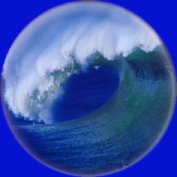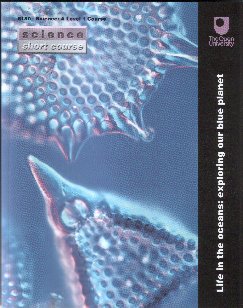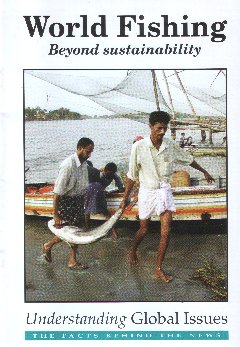
S180 Life in the Oceans: Exploring our Blue Planet
BBC "Blue Planet"
National Marine Aquarium (Plymouth)
Marine Conservation Society
Aquarius Underwater Laboratory
Routes S180 Links
Bill's Journal
Back to OU
17th March 2005
I've happy with this! :)

12th January 2005
I sent my ECA on Monday (10th). It was, actually, a very time-consuming ECA - not excrutiatingly difficult (except for one or two places!) - but lots of it. Hope I've done enough to pass! I enjoyed this course - especially the stuff about fishing - although absolutely appalled by the damage some fishing methods do to coral reefs - and the cyanide used to catch fish for home aquariums.
8th December 2004
Making steady (FAST!) progress now that I've finished S293 (all but one question of that ECA):
Summary of "From Lifeless Abyss To Cradle of Creation"
1. The Mid-Atlantic Ridge is a spreading axis where hot magma rises to form new ocean floor. The sea-bed at ridge crests is very rough, but as new oceanic crust moves away from the axis, it cools and subsides, and becomes progressively covered by sediment. Eventually, the rough topography is completely blanketed by sediments: the resulting abyssal plains are the flattest regions on Earth and are 3-5 km below sea-level. (The rough topography of the crest and flanks of the Mid-Atlantic Ridge was nor revealed by the relatively few depth soundings available to Maury in the 1850s).
2. One of the greatest and most influencial scientists of the nineteenth century was Thomas Henry Huxley. Arguably, Huxley's most important legacies to the scientific community were his efforts to get science 'organized', and his work in scientific education.
3. Huxley was not infallible. His two most important mistakes concerned the 'continunity of the chalk' and his 'discovery' of a single-celled organism (which he named Bathybius) covering samples of deep-sea mud. Most, if not all, samples of Bathybius were nothing more than hydrated calcium sulphate. Huxley's suggestion that the gelatinous substance was a mass of protoplasm was eagerly seized on by many scientists because it was thought that Bathybius might be the simplest possible organism from which all others have evolved. It is just possible that some samples of Bathybius - those collected in the springtime - were aggregates of marine snow.
4. Since the 1940s, photographs taken on the sea-bed have been challenging many of our asusmptions about the deep sea. We now know that conditions for life on the sea-bed are not constant: there are strong bottom currents and a variable food supply. Superimposed on the steady supply of fine organic debris from the photic zone are 'food bonanzas' - the carcasses of larger marine animlas and, in mid-latitudes in spring, aggregates of debris from the plankton bloom, known as marine snow (or 'fluff'), which sinks down to the sea-bed in a matter of weeks. Benthic animal life consists of deposit-feeders and suspension-feeders (which depend on organic debris from the photic zone), and carnivores. Some biological oceanographers believe that the diversity of life in the deep sea may be as great as that in the tropical rainforests.
and
Summary of "An Alternative Way Of Life"
1. The American deep-diving submersible Alvin was developed as a result of the foresight and determination of a small group of scientists who believed that if the deep ocean floor is to be understood it needs to be observed at first hand. The scientific value of deep-diving submersibles was first proved during the FAMOUS project, when close-up examination of a section of the axial rift of the Mid-Atlantic Ridge provided important clues to the volcanic processes that accompany sea-floor spreading.
2. Although indications of past hydrothermal activity were observed during the FAMOUS project, water warmed by circulating through hot oceanic crust was not found. However, in 1977, warm-water vents were discovered in the Pacific, on the (fast-spreading) Galapagos spreading axis. Also found - but not identified - were the chimneys of extinct black smokers.
3. During hydrothermal circulation, heated seawater reacts with hot oceanic crust, with the result that the compositions of both are changed. In particular, seawater loses magnesium and sulphate (which is converted to sulphide), and gains (among others) iron, manganese, silicon and calcium. Hydrothermal activity thus provides the extra 'source' (in the case of, say, manganese) or 'sink' (in the case of, say, magnesium) needed to 'balance the books' for supply and removal of various elements in seawater.
4. At warm-water vents, the rising hydrothermal fluid mixes with seawater that has percolated down into the oceanic crust, with the result that the water that emerges at the sea-bed is only slightly above ambient temperature, and has a composition fairly close to that of ordinary seawater. However, by means of mixing-line calculations, it was possible to predict the temperature (~350-38 deg C) and (to some extent) the composition of undiluted hydrothermal fluid; these predictions were borne out in 1979 when black smokers were found on the East Pacific Rise. In black smokers, the rising hydrothermal fluid is isolated from 'local' seawater because the cracks in the crust are blocked by the precipitation of metal sulphides and other minerals. Precipitation continues on the top of the crust, building up the characteristic 'chimneys'.
5. The emissions from hydrothermal vents support prolific and exotic faunas, whose primary energy source is the chemical energy released by sulphide-oxidizing bacteria. Some larger vent organisms live symbiotically with the chemosynthetic bacteria, some feed driectly on them, and yet others are carnivores. Similar communities have been found at 'cold seeps' and living on whale bones; carcasses of large marine mammals could provide 'stepping stones' for vent species. Life may have begun with bacterial chemosynthesis in the deep sea.
7th December 2004
This is a pretty restful and enjoyable little course! I've finished the main book (and all the videos), doing the ECA as I go along (LOADS of it!) and am now started on the Discovering the Deep Ocean book. There were no 'summaries' in the main book - but there are in the DDO; starting with this:
Summary of Clear, Still and Heavier Than Molten Gold
1. Until the 1860s, almost all scientists and seamen were firmly convinced that, below the surface layers, the ocean and underlying sea-bed were azoic, that is, lifeless. This belief persisted partly because of the status of Edward Forbes, whose 'azoic theory' seemed well founded, partly because the incidences of animlas being brought out of deep water were not widely known, and partly because of misunderstandings about the nature of seawater (see points 2 and 4).
2. Fresh water has a density maximum at a temperature of ≈4 deg C. The assumption that seawater also has its maximum density at this temperature led people to believe that the deep ocean was filled with a stagnant, anoxic 'reservoir' of 4 deg C water. This belief was confirmed rather than refuted by deep-sea temperature measurements, which until the late 1860s were mostly obtained using thermometers that had not been protected against the effect of pressure; consequently the readings were too high. Alexander Marcet was probably the first to demonstrate that seawater behaves differently: its density increases right down to its freezing temperature of -1.9 deg C.
3. Seawater is saline because of its high concentration of dissolved ions, notably Cl-, Na+, SO42-, Mg2+, Ca2+, K+ and HCO3-. The salinity of 'average' seawater is 35 g l-1 (written as 35). Marcet discovered that whatever the salinity of a sample of seawater, and regardless of where in the ocean it comes from, the relative proportions of the various ions remain the same; this is known as the constancy of composition of seawater.
4. Seawater is only very slightly compressible; the density of deep water and hence the pressure at depth are therefore not as great as was once commonly imagined. Hydrostatic pressure P at a depth z in the ocean is given by the hydrostatic equation, P - pgz where p is the density (strictly, average density) of overlying seawater and g is the acceleration due to gravity. 10m of water exerts a pressure equal to 1 bar (105 N m-2); hece 1 m water = 1 decibar.
5. Contrary to what Forbes believed, deep-sea sediments may have a significant proportion of biogenic material. Such sediments (oozes) may be silicious, calcareous or a mixture of the two: siliceous sediments contain the remains of diatoms (plants) or radiolarians (animals); calcareous sediments are usually dominated by the remains of coccolithophores (plants) or foraminiferans (animals). All deep-sea sediments have a proportion of fine-grained pelagic clay.
6. The deep circulation of the ocean is driven by density differences (that is, it is a type of convection); as the density of seawater is determined by its temperature and salinity (plus pressure), the term thermohaline circulation is also used. Water sinks in regions where the wind pattern causes surface waters to come together (convergences) and rises to the surface in regions where winds cause surface waters to move apart (divergences).
7. The deep-sea voyages of Lightning (1868) and the Porcupine (1869 and 1870) were the forerunners of the much better known Challenger Expedition (1872-4), now thought of as marking the birth of modern oceanography. The impetus for the Lightning and the Porcupine voyages came from Charles Wyville Thomson, who bleieved that the 'azoic theory' was untenable and that, furthermore, the deep sea might contain 'living fossils' which would throw some light on the mechanisms of evolution. It was because of this possibility that the Royal Society was persuaded to help fund the Expedition and to request the assitance of the Admiralty.
8. Factors that can determine whether particular scientific investigations are undertaken include the following: preconceived ideas (the deep sea was ignored for so long because it was believed to be lifeless - see points 1 and 2); commercial factors (the numbers of deep-sea soundings increased sharply with the advent of submarine telegraph cables); and political expediency (as in the case of exploratory voyages). You will come across further examples of the influence of politics later, particularly in Chapter 4).
4th November 2004
My materials were delivered this morning - lots more goodies than with S293!! 3 videos, CD Rom, Course book, (S280's) Discovering the Deep Oceans - and other stuff, including loads on fishing! Going to make a start this afternoon!

What lives in the oceans?
Beginnings
Micro-organisms
Plants and bacteria: making organic material and breaking it down
Taxonomic classifications
Introduction to the marine environment
What is seawater?
The shape of the ocean basins
Shorelines, sediments and the sea-bed
Tides
What causes the tides?
The influence of tides on marine life
Feeding strategies and techniques
Hitching a ride on the tide
Staying put, in spite of the tide
Tides and weather
Light, life and nutrients
Why the Earth has seasons
Light in the oceans
Heat, light, mixing and nutrients
Meroplankton - just passing through
The oxygen minimum layer
The sound channel
Winds, currents and life
The global wind system
Wind-driven currents
The effects of islands
Fronts
Ecosystems and food webs
Fish design
Different classes of fish
Fish shape, fins and tails
Lift and buoyancy
Swimming muscles
Schooling
Coral reefs
What is a coral?
Where are coral reefs found?
The reef community
The influence of wave action on reefs
Does coral have a long-term future?
Polar seas
Arctic and Antarctic: poles apart
Ice and productivity
Coping with cold
Marine mammals
The food web in Arctic seas
The 'fragile Arctic'
Migrations
Whale migrations
Fish migrations
Vertical migration
The deep ocean
Another look at buoyancy, fish muscle and bioluminescence
Guide for DDO 'Clear, still and heavier than molten gold'
(DDO: The azoic theory; The 4-degree fallacy; The launch of the Challenger Expedition)
Guide for DDO 'From lifeless abyss to cradle of creation'
(DDO: The continuity of chalk; The stange story of Bathybius; 'Bathysnap' and beyond)
Guide for DDO 'An alternative way of life'
(DDO: A FAMOUS adventure; Getting warmer .... ; Whales as stepping-stones; Postscript)
 |
Introduction: Exploiting the boundless deep The Blue Planet: By far the biggest proportion of the biosphere The Aquatic Harvest: Fish accounts for 15% of human intake of animal protein The Marine Environment: A complex ecosystem The Technology of Fishing: From simple rod and line to computerised factory ships. Topic map and charts: Global sea catches; Plankton-rich areas; The EU's Total Allowable Catches World Fishing Industry: Rising demand, limited natural resources Marine Resources at Risk: Destroying both breeding stocks and breeding grounds Fisheries Management: Manage or be damned |
14th October 2004
I wanted to do A174 (Writing Fiction) over the winter, but they had a deadline for registration, which nobody knew about ....
But this should be an interesting course - and I need to find out about cod for my U316 project! :) The course is based on the BBC series "Blue Planet" (which I didn't see!).
This course explores life in the oceans and how it is influenced by the shape of the ocean basins and the chemistry of seawater, as well as by the tides and currents. The middle part of the course explores the still mysterious realm of the deep ocean, and the last section looks at modern fishing techniques and their far-reaching consequences for marine life.